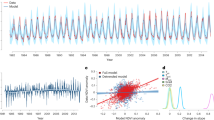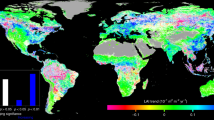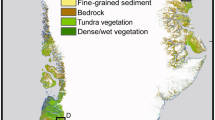Abstract
Changes in the phenology of vegetation activity may accelerate or dampen rates of climate change by altering energy exchanges between the land surface and the atmosphere1,2 and can threaten species with synchronized life cycles3,4,5. Current knowledge of long-term changes in vegetation activity is regional6,7,8, or restricted to highly integrated measures of change such as net primary productivity9,10,11,12,13, which mask details that are relevant for Earth system dynamics. Such details can be revealed by measuring changes in the phenology of vegetation activity. Here we undertake a comprehensive global assessment of changes in vegetation phenology. We show that the phenology of vegetation activity changed severely (by more than 2 standard deviations in one or more dimensions of phenological change) on 54% of the global land surface between 1981 and 2012. Our analysis confirms previously detected changes in the boreal and northern temperate regions6,7,8. The adverse consequences of these northern phenological shifts for land-surface–climate feedbacks1, ecosystems4 and species3 are well known. Our study reveals equally severe phenological changes in the southern hemisphere, where consequences for the energy budget and the likelihood of phenological mismatches are unknown. Our analysis provides a sensitive and direct measurement of ecosystem functioning, making it useful both for monitoring change and for testing the reliability of early warning signals of change14.
This is a preview of subscription content, access via your institution
Access options
Subscribe to this journal
Receive 12 print issues and online access
$209.00 per year
only $17.42 per issue
Buy this article
- Purchase on Springer Link
- Instant access to full article PDF
Prices may be subject to local taxes which are calculated during checkout



Similar content being viewed by others
References
Bonan, G. B. Forests and climate change: Forcings, feedbacks, and the climate benefits of forests. Science 320, 1444–1449 (2008).
Myhre, G. et al. in Climate Change 2013: The Physical Science Basis (eds Stocker, T. F. et al.) 659–740 (IPCC, Cambridge Univ. Press, 2013).
Both, C., Bouwhuis, S., Lessells, C. M. & Visser, M. E. Climate change and population declines in a long-distance migratory bird. Nature 441, 81–83 (2006).
Post, E. et al. Ecological dynamics across the Arctic associated with recent climate change. Science 325, 1355–1358 (2009).
Thomas, C. D. et al. Extinction risk from climate change. Nature 427, 145–148 (2004).
Zhu, W. et al. Extension of the growing season due to delayed autumn over mid and high latitudes in North America during 1982–2006. Glob. Ecol. Biogeogr. 21, 260–271 (2012).
White, M. A. et al. Intercomparison, interpretation, and assessment of spring phenology in North America estimated from remote sensing for 1982–2006. Glob. Change Biol. 15, 2335–2359 (2009).
Zhou, L. et al. Variations in northern vegetation activity inferred from satellite data of vegetation index during 1981 to 1999. J. Geophys. Res. 106, 20069–20083 (2001).
Nemani, R. R. et al. Climate-driven increases in global terrestrial net primary production from 1982 to 1999. Science 300, 1560–1563 (2003).
Ciais, P. et al. Europe-wide reduction in primary productivity caused by the heat and drought in 2003. Nature 437, 529–533 (2005).
Zhao, M. & Running, S. W. Drought-induced reduction in global terrestrial net primary production from 2000 through 2009. Science 329, 940–943 (2010).
Running, S. W. et al. A continuous satellite-derived measure of global terrestrial primary production. Bioscience 54, 547–560 (2004).
De Jong, R., Verbesselt, J., Schaepman, M. E. & de Bruin, S. Trend changes in global greening and browning: Contribution of short-term trends to longer-term change. Glob. Change Biol. 18, 642–655 (2012).
Scheffer, M. et al. Anticipating critical transitions. Science 338, 344–348 (2012).
Parmesan, C. & Yohe, G. A globally coherent fingerprint of climate change impacts across natural systems. Nature 421, 37–42 (2003).
Root, T., Price, J. & Hall, K. Fingerprints of global warming on wild animals and plants. Nature 421, 57–60 (2003).
Menzel, A. et al. European phenological response to climate change matches the warming pattern. Glob. Change Biol. 12, 1969–1976 (2006).
Reyes-Fox, M. et al. Elevated CO2 further lengthens growing season under warming conditions. Nature 510, 259–262 (2014).
Freedman, J., Fitzjarrald, D., Moore, K. & Sakai, R. Boundary layer clouds and vegetation–atmosphere feedbacks. J. Clim. 14, 180–197 (2001).
Samanta, A. et al. Comment on “Drought-induced reduction in global terrestrial net primary production from 2000 through 2009”. Science 333, 1093 (2011).
Ray, D. K., Ramankutty, N., Mueller, N. D., West, P. C. & Foley, J. A. Recent patterns of crop yield growth and stagnation. Nature Commun. 3, 1293 (2012).
Olsson, L., Eklundh, L. & Ardö, J. A recent greening of the Sahel—trends, patterns and potential causes. J. Arid Environ. 63, 556–566 (2005).
Paruelo, J. M., Garbulsky, M. F., Guerschman, J. P. & Jobbágy, E. G. Two decades of Normalized Difference Vegetation Index changes in South America: Identifying the imprint of global change. Int. J. Remote Sensing 25, 2793–2806 (2004).
Lehmann, C. E. R. et al. Savanna vegetation–fire–climate relationships differ among continents. Science 343, 548–552 (2014).
Higgins, S. I., Delgado-Cartay, M. D., February, E. C. & Combrink, H. J. Is there a temporal niche separation in the leaf phenology of savanna trees and grasses? J. Biogeogr. 38, 2165–2175 (2011).
Flato, G. J. et al. in Climate Change 2013: The Physical Science Basis (eds Stocker, T. F. et al.) 741–866 (IPCC, Cambridge Univ. Press, 2013).
Field, C. B., Jackson, R. B. & Mooney, H. A. Stomatal responses to increased CO2: Implications from the plant to the global scale. Plant Cell Environ. 18, 1214–1225 (1995).
Buitenwerf, R., Bond, W. J., Stevens, N. & Trollope, W. S. W. Increased tree densities in South African savannas: > 50 years of data suggests CO2 as a driver. Glob. Change Biol. 18, 675–684 (2012).
Poulter, B. et al. Contribution of semi-arid ecosystems to interannual variability of the global carbon cycle. Nature 509, 600–603 (2014).
Pinzon, J. E. & Tucker, C. J. A non-stationary 1981–2012 AVHRR NDVI3g time series. Remote Sensing 6, 6929–6960 (2014).
Fridley, J. D. Extended leaf phenology and the autumn niche in deciduous forest invasions. Nature 485, 359–362 (2012).
Acknowledgements
This work was funded by the Deutsche Forschungsgemeinschaft. We thank the GIMMS group for making data available, Forschungsgemeinschaft Frankfurt Cloud for providing computer resources, and the University of Otago for hosting R.B.
Author information
Authors and Affiliations
Contributions
R.B. and S.I.H. designed the study and data analyses. R.B. performed the analyses with assistance from L.R. R.B. wrote the manuscript with assistance from S.I.H. All authors discussed and commented on the manuscript.
Corresponding author
Ethics declarations
Competing interests
The authors declare no competing financial interests.
Supplementary information
Rights and permissions
About this article
Cite this article
Buitenwerf, R., Rose, L. & Higgins, S. Three decades of multi-dimensional change in global leaf phenology. Nature Clim Change 5, 364–368 (2015). https://doi.org/10.1038/nclimate2533
Received:
Accepted:
Published:
Issue Date:
DOI: https://doi.org/10.1038/nclimate2533
This article is cited by
-
Seasonal compensation implied no weakening of the land carbon sink in the Northern Hemisphere under the 2015/2016 El Niño
Science China Earth Sciences (2024)
-
Shifts in vegetation activity of terrestrial ecosystems attributable to climate trends
Nature Geoscience (2023)
-
An earlier start of the thermal growing season enhances tree growth in cold humid areas but not in dry areas
Nature Ecology & Evolution (2022)
-
Study of the impact of ash fallout from the Icelandic volcano Eyjafjöll (2010) on vegetation using MODIS data
Natural Hazards (2022)
-
Impact of land use/land cover types on surface humidity in northern China in the early 21st century
Journal of Arid Land (2022)



